The post We live in the age of the ‘Next Big Thing’ appeared first on Inside Social Media.
]]>
Post by Nate Paul
The latest and greatest smartphones are released every twelve months, rendering the last model about as useful as a paperweight (if you believe the marketing hype). An entire industry has been built around Silicon Valley’s cult of disruption, a belief that we should always be replacing our old way of thinking and doing with new and exciting ideas.
It seems like nothing is safe from our love affair with newness. In the coming years, cars will relieve us of the burden of sitting behind the wheel and smart refrigerators will relieve us of the worry of remembering to pick up milk.
Don’t get me wrong – I love technology. In fact, one of the most gratifying parts of my job is working with software and technology companies and the growth of their businesses. It’s hard not to be excited by the endless ways that innovation will change our lives for the better in the years to come.
But while many of my friends and colleagues spend their free time reading about the future of robotics and artificial intelligence and thinking about how the Internet of Things will change our daily lives, I far more often find myself thumbing through decades-old issues of Forbes, Businessweek or Fortune, soaking up as much insight as I can from great dealmakers now relegated to the history books.
One mainstay on my nightstand is a battered old copy of Business Adventures by John Brooks that I bought from an actual bookstore (not online!) when I was in high school. The book was originally published in 1969, but the insights remain astonishingly relevant today. The passage I probably re-read the most is about the Ford Edsel fiasco, which is the ultimate cautionary tale about the importance of paying close attention to your market and being ready to respond when your customers’ preferences and demands change. It’s no surprise to many that the business leaders I admire, including Bill Gates and Warren Buffett, are fans of Brooks and his timeless wisdom.
One of the core lessons the greatest investors and business leaders share is an obsession with the fundamentals. In hot markets like today, in which unicorns and pre-revenue billion dollar valuations grab all the headlines, it’s easy to lose sight of the basics.
But sizzling markets and the lure of quick profits is nothing new. When I started investing in real estate in 2007 while still a college student, the market was saturated with speculators. The previous few years had seen unprecedented capital growth in the residential and commercial markets, and suddenly everyone was a developer or a flipper. Finding properties that were undervalued and had strong fundamentals was extremely difficult at the time, because the competition was snapping up everything they could find and counting on never-ending price appreciation.
Going against the grain, I began building my company by obsessing over the fundamentals – intrinsic value, recurring cash flow, and a long-term investment horizon. When the real estate market collapsed in 2008, I managed not to panic or flee, and once again went against the grain, becoming one of the most active buyers of real estate in Austin…then Texas…and eventually, the nation. Following Buffett’s advice, I was fearful when others were greedy – and then positioned to be greedy when others were fearful.
This old school approach doesn’t just apply to investing, it applies to almost every aspect of building and running a company. In business and investing, cautionary tales are everywhere – from the one-hit wonder Wall Street fund manager who delivers one knockout year and then flames out, to the Silicon Valley rising star who builds a killer app and is never heard from again. Those of us who have achieved success at a young age should be terrified by these examples. I’m driven every morning to build a company that creates jobs, wealth and economic opportunity not just for years, but for generations. I can’t imagine how to do that except for being a student of history.
I’ve never liked the old saying that those who don’t study history are doomed to repeat it. To me, history is a goldmine of proven ideas just waiting to be uncovered. It may just be that the “Next Big Thing” happened long ago.
The post We live in the age of the ‘Next Big Thing’ appeared first on Inside Social Media.
]]>The post Kimberly-Clark uses social quiz to woo talent appeared first on Inside Social Media.
]]>

 Are you an original thinker? You can quickly find out by taking the Welcome Original Thinkers Quiz (WOTQuiz)—I’m an Adaptor:
Are you an original thinker? You can quickly find out by taking the Welcome Original Thinkers Quiz (WOTQuiz)—I’m an Adaptor:
“You enjoy exploring every side of an issue and like a wicked great maestro you tease out the positive in each approach. Your resourcefulness and ability to easily adapt to the latest input often makes you the one who finds answers to the most challenging questions.”
What did you get? Please be sure to let me know in the comments.
Kimberly-Clark created a BuzzFeed-inspired quiz to discover their own Original Thinker type and then are rewarded with a new emoji badge suitable for social sharing, as well as an invitation to find out about original thinkers at Kimberly-Clark.
BOOve over Silicon Valley, Austin, TECHxas, and the Big Apple; welcome original thinkers to Neenah, Wisconsin, where young creative chemical and product engineers can find the job of their dreams.
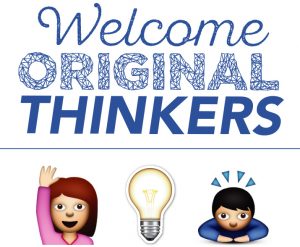 Kimberly-Clark is looking for bright, talented thinkers who are eager to explore ideas, solve problems, and be part of collaborative teams and a performance-based culture that is focused on being number one in its markets. They’re using this online quiz to help prospective employees learn what kind of thinkers they are, what kind of jobs they’d best fit, and in the process, show that the 144-year-old paper and personal-care products company and its Neenah home base are cool and offers a balance of life that’s probably more fulfilling than a lot of other places. Kimberly-Clark’s culture is one where employees can and do routinely turn their ideas into winning, profitable and life-changing solutions.
Kimberly-Clark is looking for bright, talented thinkers who are eager to explore ideas, solve problems, and be part of collaborative teams and a performance-based culture that is focused on being number one in its markets. They’re using this online quiz to help prospective employees learn what kind of thinkers they are, what kind of jobs they’d best fit, and in the process, show that the 144-year-old paper and personal-care products company and its Neenah home base are cool and offers a balance of life that’s probably more fulfilling than a lot of other places. Kimberly-Clark’s culture is one where employees can and do routinely turn their ideas into winning, profitable and life-changing solutions.
As part of this campaign, my agency, Gerris Corp, is helping Kimberly-Clark get the word out using an extensive and aggressive earned-media micro-influencer marketing campaign in close formation with Kimberly-Clark’s People Strategy department and their AOR, Relish Marketing.
 I first worked with Kimberly-Clark back in 2008 to help reduce the spread of healthcare associated infections and, after eight more years, we get to work together again. From HAIWatch to WOTQuiz!
I first worked with Kimberly-Clark back in 2008 to help reduce the spread of healthcare associated infections and, after eight more years, we get to work together again. From HAIWatch to WOTQuiz!
Again, this is a campaign where we’re targeting influencer verticals in order to engage them, share the quick fun quiz with them, and then brief them on what the campaign’s about and why Kimberly-Clark is promoting a personality quiz in the first place.
So far, people are in love with the different types of personality types, including the dreamer, analyzer, disrupter, muse, adaptor, nonconformist, maker, and inventor.
Our goal is the same as the goal of the quiz: get folks to take the quiz, find out their Original Thinker type, and then share their emoji badges via social media, sharing with all their friends via Facebook, LinkedIn, and Twitter.
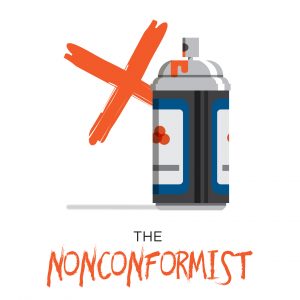 Sounds easy, but easier said than done. “If you build it, they will come” never works so we get to be the vanguard of the movement, sparking and catalyzing all viral-making fun!
Sounds easy, but easier said than done. “If you build it, they will come” never works so we get to be the vanguard of the movement, sparking and catalyzing all viral-making fun!
In support of this campaign, we’ve built a gorgeous Social Media News Release (SMNR)—wotquizinfo.com—the nicest one we’ve ever built for a campaign, and we’ve registered a bespoke domain name, wotquiz.com, to make sure everything is very simple and accessible to anyone we message.
Earned media micro-influencer marketing doesn’t need to be limited to consumer campaigns for unicorn companies like Skinny Coconut Oil. Earned-media micro-influencer marketing works beautifully in the service of hearts and minds campaigns such as quizzes, tests, and polls.
Let me know if you have any questions. If you’d like more information, feel free to contact me.
Via Biznology
The post Kimberly-Clark uses social quiz to woo talent appeared first on Inside Social Media.
]]>The post Social media metrics for small businesses: 4 tools appeared first on Inside Social Media.
]]>Post by Adi Englander
 One of the biggest challenges that small businesses face with social media is cutting through the bewildering fog of metrics to focus on what truly matters.
One of the biggest challenges that small businesses face with social media is cutting through the bewildering fog of metrics to focus on what truly matters.
Why is this such a big challenge?
Because according to Manta, 60% of businesses reported that they didn’t gain any benefit from social media engagement.
As David Spark pointed out in the aptly named article “Are you using social media to serve your needs?”: “Every time you delve into a new social media program, ask yourself what purpose it fills for you personally or professionally.”
The antidote is to “focus entirely on what you’re trying to accomplish with your social media program or campaign and then identify the Key Performance Indicators that will tell you, over time, whether you’re getting there.”
Unfortunately, only a few tools show the effect that your social media activity is creating in the real world.
So, if you’d like to take a good look at what’s actually converting and bringing in sales, these four tools are absolutely essential.
Oktopost
Oktopost is the only social media platform designed specifically for B2B management.

While a tool like Buffer helps you schedule posts and makes sharing easy, Oktopost is the first solution that establishes the ROI of social media by integrating clicks and conversions into today’s social-centric marketplace.
When it comes to social media management, one key metric is tracking the number of leads generated through different marketing efforts. With Oktopost you get a Leads tab that shows the conversions achieved from each platform. This Leads tab tracks from which social media network the conversions came, along with the total number of conversions by campaign, all of which can be exported via CSV.
Klout
Klout is the golden standard in measuring social media influence and reach.
 Image Credit: http://allthingsd.com/files/2012/08/Klout-dashboard-feature.jpg
Image Credit: http://allthingsd.com/files/2012/08/Klout-dashboard-feature.jpg
Klout tracks multiple social media platforms and measures your overall presence with a numerical score. It also shows you which social media outlets are performing the best as well as where there’s room for improvement.
By using over 35 different variables to measure your social media influence, Klout’s “True Reach” feature is especially helpful for because it separates true followers from bots or spammers to give you a realistic measure of your brand’s popularity.
Klout even helps you identify sharable content. In the above dashboard, you can view suggested articles related to the topics based on your profile. Sharing these articles improves your Klout score and, more importantly, connects you to the influencers who matter in your niche.
Hootsuite
Hootsuite is a social media management tool that integrates different platforms like Twitter, LinkedIn, Facebook, and more into a single dashboard.

Image Credit: https://www.brandwatch.com/wp-content/uploads/2013/08/hootsuite-screenshot.png
One of the most helpful metrics Hootsuite tracks is what’s called “sentiment.” Like its title suggests, “sentiment” measures the emotion behind a social media mention. Was the person sharing the post happy, angry, sad, excited, or disappointed? This can be especially helpful to determine if your brand is turning sour among users and doing the right things.
For business owners who lack time to manage social media, Hootsuite’s a boon because you can see streams from Twitter, Facebook, Instagram and over 50 other social media accounts on the Hootsuite dashboard. You can even manage multiple accounts on the same channel like different Facebook pages or even add employee accounts.
The most powerful feature on HootSuite is the influencer tab. As you can see, the influencer reveals the actual followers of particular influencers, the number of updates they have posted, their Klout score, whom they are following, and bio details. This information helps you craft content that connects with the top performers in your industry and builds truly profitable relationships.

Cyfe
Cyfe is a genuinely all-in-one dashboard.

For social media, this means you can integrate your campaigns into the overall stream of your business and measure not just what’s generating clicks and shares … but actual sales.
Most of the tools featured above offer a centralized dashboard for social media.
Cyfe , on the other hand, offers a dashboard where you can see web-analytics, social-media activity, marketing activity, sales activity, progress of projects, and so on. By giving you the big picture, Cyfe saves time, money, and heartache.
The social media dashboard (shown below) for example offers all your data in a visually appealing and easy-to-manage manner. You can track the total reach of your posts, their views, number of people who engaged, and virtually any other metric.
Metrics that matter
For most small businesses, social media can be a serious waste of time, effort, and money.
Why?
Because they’re not able to truly measure the value of their activities in the real world.
The four social-media tools above solve that fundamental problem and allow you to measure your progress and see what’s actually working. A solid social media strategy, coupled with the right tools can make
The post Social media metrics for small businesses: 4 tools appeared first on Inside Social Media.
]]>The post 3 Ways Your B2B Social Media Marketing Needs to Be Helpful appeared first on Inside Social Media.
]]>
Post by Daniel Kushner
Founder, Oktopost
The rise of social media over the past decade has forever changed the way businesses go about capturing, pursuing and closing leads. Nowadays, B2B purchasing only takes place once prospects have begun to truly trust a vendor that they’re looking into, as relationships are now formed far earlier in the purchase cycle, with buyers investing heavily in self-service research – often across several digital channels.
For vendors, this changing dynamic calls for enabling the research process. Today’s digitally connected B2B vendors know that educating and being generous with helpful advice on social media is the most effective way to position their companies as valuable partners.
Businesses and consumers alike are interested in investing far more on product research today than we did before the social age. According to Jay Baer’s Youtility, in 2010, when social media’s pervasiveness had begun to take hold, shoppers needed an average of 5.3 sources of information to make a decision. By 2011, that number had almost doubled to 10.4.
In order to achieve high levels of performance with your social media marketing, you need to remember how the B2B procurement process works from the perspective of the buyer. The research process can be heavy on resources, and the people whose job it is to perform the research are often not the same people who make the final sourcing decisions.
Here are three pivotal ways that your B2B social media marketing needs to be helpful.
1. Prove your ROI
How can the purchasing business profit from your product or service? There are two main ways of proving that your offer is beneficial. The first is if it solves a major pain point for the business. If your solution can save your prospects time, money or other resources, then you’ll have a much better chance of making a sale.
The second way to demonstrate the potential for return on investment is, of course, proving that your product or service will increase revenues for your B2B prospect. Either way, by emphasizing the business case for your solution, you’ll be giving researchers on the prospecting end powerful ammunition for convincing their superiors about you.
Perhaps the most effective tactic for talking up you solution’s usefulness as a profit booster is to share case studies on your social media channels. Publish content about businesses you have helped in the past, and share concrete numbers, before and after. The profits are in the proof.
2. Cut to the chase
Unlike the world of B2C marketing, where social media marketing emphasizes building “image,” brand equity and positive sentiment over time, B2B social media means getting down to the nitty-gritty.
Keep in mind that business people are usually overworked and have mile-long to-do lists, so the faster you can connect them with the information they need, the more likely they are to want to work with you. Some B2B consumers will happily click around dozens of websites, social feeds and resource libraries before they figure out what it is that they want.
But many businesses just don’t have that kind of time. Time is money for them, so success means presenting, as clearly and simply as possible, your solution’s value proposition, focusing on how you can benefit your prospect’s business.
3. Emphasize consensus
Remember – the person you’re interacting with may not actually have the authority to sign checks. One distinct challenge in B2B marketing is that you’re selling to a business and not to an end consumer. That means that your social engagement is likely to be with a lower-down employee in a prospective customer company, someone who may not have the final signing authority. It may simply be his or her job to do research and perhaps to build a report that highlights his or her top choices. The decision then may go to the researcher’s boss, or the researcher’s boss’s boss, or even a committee or board.
So B2B marketers often indirectly sell their products to someone that has no specific knowledge of your field of expertise. That’s why it’s so important to stay away from highly technical language and instead stick to the tried-and-true basics, as listed above. But perhaps most importantly, try to foresee what specific pieces of information the employee you are dealing with will need to sell your product or service to his or her superiors.
When selling to businesses on social media, your posts and interactions should enable the B2B procurement pipeline by supplying prospects with the paperwork, documentation and supplementary information necessary to expedite B2B processes. And when you put your solution in the context of universal truths, you’re effectively giving everyone involved, regardless of their placement on the totem pole, what they need to know to seal the deal. Do your prospects’ jobs for them, and they will be grateful to you for your service, and there is a higher likelihood of closing a sale.
Help that meets demand
The key to B2B social media mastery is, therefore, incorporating the dynamics of today’s procurement processes into every interaction.
Provide true value to the people you’re engaging with by always proving your product’s ROI, positioning your solution as the answer for all relevant pain points, and in a way that builds trust and enables expediting the contemporary B2B sourcing pipeline.
The post 3 Ways Your B2B Social Media Marketing Needs to Be Helpful appeared first on Inside Social Media.
]]>The post Best practices for nurturing B2B leads captured via social media appeared first on Inside Social Media.
]]>Founder, Oktopost
Thanks to the reality of social media’s astounding adoption rates, B2B marketers are finally moving away from the debate as to the value of their activity on the main networks. With so much of the world now spending significant amounts of time on Facebook, Twitter, LinkedIn, Instagram and the like, it simply makes the most sense to leverage these platforms to reach your intended audience – this is where they are, so this is where you have to be.
Despite all the talk about silos being a thing of the past, B2B social media marketing activity is extremely different from B2C. Simply keeping your brand name at the forefront of people’s minds doesn’t cut it in sectors that involve such drawn-out and deliberate procurement processes. When your aim is driving sales for a product that targets fellow businesspeople, social media’s greatest impact is realized when it’s used as a mechanism for lead capture and nurturing.
Channels for Relationships of Trust
At its best, social media is all about conversations and engagement, and that’s the basis of effective lead nurturing too. Marketers who are great at building relationships of trust with relevant leads online prefer to identify prospects, discuss their solutions, distribute content and drive traffic to owned properties via social media. In fact, some 94% of the B2B marketers in the United States use LinkedIn as a key content distribution channel, and 88% use Twitter. What’s more, B2B marketers are increasingly citing LinkedIn and blogs as pivotal customer acquisition channels.
Clearly, social realms have finally matured enough to be considered serious B2B lead nurturing venues. But success here depends on maintaining a clear sense of strategy and goals. We’re easily confused into thinking that a high volume of likes, shares and comments means we’ve succeeded. B2B marketers should instead be thinking about how to encourage leads captured via social media to advance along the sales funnel.
When a stranger or a known prospect comments on a blog, likes a Facebook post, retweets a company tweet or chimes in on a LinkedIn Group discussion, this is an opportunity that should not be wasted. Any of these actions can be considered a micro-conversion and therefore a first step toward a purchase. Even a click from a social channel to your website is an important micro-conversion which, if nurtured properly, can lead to a sale.
Who, Why and What Next
When a B2B lead first interacts with a social media post, he or she is most likely to be at the research stage, and your interactions should be tackled accordingly. He or she may be interested in your product, but that doesn’t indicate that he or she has any idea yet if it will meet his or her needs, if it’s worth the price or if your company has any genuine expertise. Don’t turn people off by getting too sales-y on them.
Rather, this could the perfect time to share some educational content in a private message to start building the case that you have the solution to his or her business challenges. Once each B2B lead has advanced enough to be considered a marketing qualified lead (MQL), your sales team takes over and hopefully finalizes the purchase. Each stage of the funnel has matching content types and engagement styles that are most effective; keep these in mind, and you’ll be able to turn your social media activity into a lead nurturing powerhouse.
If you have access to advanced tracking data via premium analytics tools, you can easily determine each of your prospects’ closest-matching buyer personas and position in the sales funnel by correlating onsite activity with the decision making journey as you’ve mapped it out.
But even if you aren’t yet set up for this level of business intelligence, simply knowing what social media channel and post originally referred your prospect and what type of micro-conversions he or she has performed will already give you lots of clues into who your lead is and how interested in your product he or she is. Use this information to send messaging appropriate to personas and to stages in the funnel. With effective nurturing, getting the right message to your prospects at the right moments is the key to making a sale.
Choosing the Right Message
Follow these general guidelines to successfully use messages for B2B nurturing in ways that match various types of micro-conversions.
- A lead that first comes to your awareness via a comment on your blog is likely interested in more information about the general topic of the post in question. Use this opportunity to answer the lead’s questions and establish a position of niche thought leadership and trust.
- When someone initially connects with your company via Twitter, use the opportunity to engage in light, friendly discussion that goes in whatever direction your prospect determines. Provide informative advice and don’t hesitate to tell a prospect they should look elsewhere if necessary.
- When someone micro-converts on LinkedIn, do some research into the company he or she works for. Determine what kind of issues they may be having and offer some well-thought-out, personalized insights, always emphasizing the benefits of your solution rather than its specs.
- When a prospect responds positively to an automated email that includes educational content, he or she is likely ready to receive somewhat more sales-oriented content.
- Once you see someone clicking through often to sales-focused content, address any loose ends you’ve been discussing with the prospect, and then you should be ready to hand him or her over to the sales team.
Tipping Point from Marketing to Sales
Your company’s marketing team nurtures leads until they’re ready for a sales call. If this happens too early, your prospects may feel pressured and jump ship, but if the sales team arrives on the scene too late, the prospect may have already closed a deal with a competitor. Determining the optimal set of circumstances that identify a lead as being sales-ready is a pivotal aspect of social-based nurturing.
As part of your company’s ongoing marketing operations, the sales and marketing teams must sit down together regularly to review trends and redefine what makes a lead sales-ready. Most B2B enterprises use complex lead scoring formulas for this purpose, whereby each lead accumulates points until reaching the magic number. Once a lead has been assigned a specific number of points, he or she is considered to be a MQL and becomes the responsibility of the sales team.
Points are awarded for each type of micro-conversion and any number of browsing activity patterns on your site, but they’re also awarded for segmenting data gleaned from other sources. For instance, a lead captured via LinkedIn might receive more points than one from Facebook. An executive at a company may be worth more points than a lower-level employee.
Additional segmentation patterns are likely to emerge as you engage in a regular sales-marketing feedback loop whereby conversion rates are correlated with MQL factors. For example, you may find that leads captured via social media on certain days of the week deserve more points, or leads captured via specific landing pages deserve fewer points. A good lead scoring program takes all these elements into account, assigns values to each action and parameter, and regularly reviews any needs to tweak these formulas.
Lather, Rinse, Repeat
As with any marketing effort, lead scoring and nurturing is not a one-time project. Set up an initial lead scoring point system, but don’t forget to go back to it and rethink what exactly constitutes an MQL. External and internal factors will influence the lead nurturing process, so you need to be open to changing your system as necessary.
And keep in mind that social media is not just about getting likes on photos of kittens. It is an important tool in the lead nurturing process – one that can outperform all others and drive sales when appropriate emphasis is placed on leveraging data for optimized lead scoring and nurturing.
The post Best practices for nurturing B2B leads captured via social media appeared first on Inside Social Media.
]]>The post Email Marketing as Easy as Webmail appeared first on Inside Social Media.
]]>
Target audience: Marketing professionals, SEO specialists, PR pros, brand managers, businesses, nonprofits, educators, Web publishers, journalists.
 For more than a decade, guys I respect like Chris Brogan, John Hlinko, Nicco Mele, CC Chapman, and Christopher Penn have been a broken record when it comes down to brass tacks: cultivating an email list is the only real reason to do social media marketing, content marketing, inbound marketing, guest blogging, or column-writing. I take that back, selling and making money is the only reason, at the end of the day, but just ask anyone in the world of fundraising, ecommerce, and sales the true value, in dollars, of a fresh, segmented, double-opt-in, targeted list, per subscriber, and I bet you’ll pop your wig (upwards of $3+ per-record for really desirable lists).
For more than a decade, guys I respect like Chris Brogan, John Hlinko, Nicco Mele, CC Chapman, and Christopher Penn have been a broken record when it comes down to brass tacks: cultivating an email list is the only real reason to do social media marketing, content marketing, inbound marketing, guest blogging, or column-writing. I take that back, selling and making money is the only reason, at the end of the day, but just ask anyone in the world of fundraising, ecommerce, and sales the true value, in dollars, of a fresh, segmented, double-opt-in, targeted list, per subscriber, and I bet you’ll pop your wig (upwards of $3+ per-record for really desirable lists).
I have never started a list. I have everything else. I have never wanted to commit to wrangling the content needed to support a hungry list. Collecting a list is one thing but actually working the list, engaging the list, and setting aside the resources and creativity necessary to get an interesting, informative, compelling, well-written, entertaining, and salient newsletter out the door, checked and edited, every week is hard enough but actually shoehorning everything into a format that is both professional-looking and also deliverable.
I have gone through the discovery phase a number of times. I think I started, back in the day, with Mailman. I loved mailman because it was just an Open source Listserv software, not a proper broadcast list.. Of course, my next try was MailChimp.com, which is at least integrated with most every other app, but while it’s come a long way, it’s still more of a framework than it is a wizard.
I live in a world of Gmail,Wordpress and SquareSpace. I live in an app world. My tools should enable me to spend all my time writing content for my list subscribers instead of all sorts of post-production “splicing” — I want to do what I do when I blog: write it up, add some photos and a title, and then click [Post].
Easy peasy.
So, in my exploration, I have come upon GetResponse, which seems to me to be sort of like the SquareSpace of direct email. Everything’s drag-and-drop, everything is template-based. The job of a perfect app, in my opinion, is a service program that makes it so easy to get to 80% perfect — totally good enough — so that all the hard stuff — setup, design, branding, customization, production, post-production — out of the way as much as possible so that you and I can get to the business of trying to fit one or more weekly missives to my prospects, clients, fans, friends, and followers (okay, twice-a-month; okay, then, monthly).
Painless Email Creator — If webmail weren’t absolutely painless to use, nobody would use it. I believe that all web apps need to be as easy at Gmail or it’s a failure. As an app developer, you have about ten minutes of good faith and attention before a new user hits the eject button and leaves forever. This all needs to be dead simple, template-driven, and every template needs to be professional, gorgeous, and good enough to only require a couple simple uploads, like a photo or two, a profile photo, and a logo and good-to-go. And, one needn’t care about file size, format, density, height, or width. You should be able to upload anything and the back end should be able to resize and optimize (hell, there are even server-based tools that can do amazing things with image-fu, including gifsicle, jpegtran, optipng, pngquant, etc.). GetResponse seems to do it’s very best to get out of the way towards getting me on the road. Writing up newsletters for the wise and sage subscribers to whom I aspire to entertain, compel, and sell should not be any harder or laborious than writing a memo to my staff or writing my weekly blog post for Biznology.com. The easier it is, the more often I will engage with my followers and, presumably, the more top of mind Gerris and I will be (if I do my part).
Simple List Building — another thing that top-of-the-line email and social media tools offer is contact-slurping. First you register, then you validate your email, then Facebook, Stitcher, LinkedIn, and even Gmail, Yahoo! Mail, and Hotmail/Live.com/Outlook.com slurp up all your other contacts, onboarding them as completely, painlessly, and quickly as possible. GetResponse slurps up everything and anything from everywhere, it’s up to you to control your lust and be smart about who you really should be sucking into your list and who you should probably just leave alone. Do all 14,000+ of your contacts really want to be on your weekly Social Media Marketing and Digital PR missives? I mean, it would be pretty nice to start a list off with over ten-thousand members, but think about it: blowback’s a bitch. Don’t include anyone who might be interested in reporting your unrequested email to the spam police (called the “List Booster”)
Landing Page Creator — Chris Brogan, John Hlinko, Nicco Mele, CC Chapman, and Christopher Penn are smart. They realize that you can play patty cake with your subscribers and followers and friends on your email lists and social media all you want; however, if you want to convert folks to customers, you need to take them further into the funnel and a landing page is, generally-speaking, tailor-suited for selling and converting casual visitors to investors in your fruitful future of milk and honey. But don’t be coy. A landing page is not the place to be all “shucks,” it’s where you can take the 7+ touches that your email marketing has proffered and turn that into a proper business relationship.
Autoresponder — I don’t use these very much but what they do do – if you’re the sort of person who is able to put the sort of work into setting up automated follow-up email cycles, birthday emails, 1-to-1 communications, and customized offers – is probably really very cool. I’m not that guy.
Responsive Email Design — this matters to me. Responsive design is one of those trendy buzzwordy trends you and I want to just dismiss out-of-hand — but don’t. It’s really something else. And, when it comes to grabbing peoples’ attention from wherever you reach them, you need it. What responsive design does is customize the look, feel, and usability exclusively based on what device, mobile or desktop, phone or tablet, big or small monitors, tiny iPhone 4 or phabulous iPhone 6+. So, since GetResponse offers responsive email templates, your email will always arrive premasticated bespoke for each and every one of your subscribers. You can check it out by using their Inbox Preview tool which allows you to preview the email you’re sending out to make sure it makes a splash on as many devices, email clients, operating systems, and browsers as possible.
In addition to these basic and essential offering, GetResponse also offers segmentation of lists; A/B testing, allowing you to try out different subject lines, images, slogans, or introductory paragraphs to see if one design, subject line, or introduction works very much better or another. You can test a little bit of the list, see how it performs, and then run with the best-performing one for the entirety of the rest of the list. It’s very cool stuff.
I have always wondered why direct email tools had been so difficult to manage. Maybe it’s because a few people have been making a lot of money by being the experts in this too-complicated and obfuscated industry. Maybe it was to control the space. MailChimp has taken a few steps towards democratizing the process but GetResponse has made direct email marketing as easy and simple as joining Facebook or registering for Gmail.
The post Email Marketing as Easy as Webmail appeared first on Inside Social Media.
]]>The post Why Google Plus is more like a forum than a social network appeared first on Inside Social Media.
]]>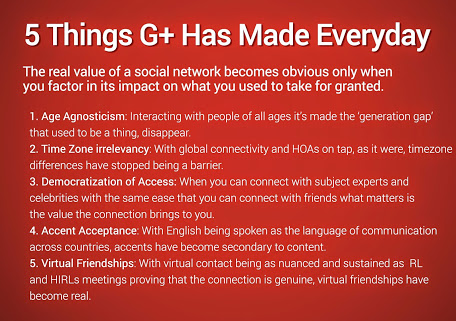
A Google+ affirmation graphic.
Tips on what works and doesn’t work on G+
This is the second of a three-part series on Google Plus. Also see:
• Hey Google! Here’s why Google+ is still a ghost town
• Why Google Plus is the antisocial network
Target audience: Marketing professionals, SEO specialists, PR pros, brand managers, businesses, nonprofits, educators, Web publishers, journalists.
 It occurred to me, after spending a week deep-diving into Google+, that Plus is not a social network — or even a social layer. It’s a global reboot of the message board.
It occurred to me, after spending a week deep-diving into Google+, that Plus is not a social network — or even a social layer. It’s a global reboot of the message board.
If you want to succeed, you need to forget about your friends and your family. Leave them behind. There are cooler, smarter, funnier people on Google+ than we have in our own lives now.
Hello to birds of a feather
It’s not where you connect with people you know, it’s where you find birds of a feather. It’s where you can find better. It’s a bona fide online community along the lines of The WELL, Slashdot, and Reddit more than it’s like LinkedIn, Pinterest, or Facebook.
When I join a forum, I don’t expect all my friends to be there already. I don’t expect brands to be there. I go there because that’s where the experts are. When I go to the ADV Rider, Motobrick, or BMW MOA forums, I don’t expect to see my cousin Joe or my high school sweetheart.
But, I do expect to meet folks who know much more about motorcycles than I do. Folks who’ve already sorted out oil changes, what to pack on an around-the-world expedition on a bike — all of that. I expect to enter a different world entirely. That’s apparently how Google+ is set up. Why bring the mundane people of your life with you? Start anew with the smartest, most creative, most interesting folks that the entire Google Globe can offer.
How to be a Google+ success
 Step one: Join Google+ (you probably already have one or more account on Google+ already that you may have checked out once, three years ago — it’s still there). Just go to your Gmail account — I know you already have one of these — and click either on the little white Rubik’s Cube or on the little bell (with the red circle with numbers over it).
Step one: Join Google+ (you probably already have one or more account on Google+ already that you may have checked out once, three years ago — it’s still there). Just go to your Gmail account — I know you already have one of these — and click either on the little white Rubik’s Cube or on the little bell (with the red circle with numbers over it).
Step two: Forgo any and all other social media platforms. Leave your other online homes and commit to G+ — even though none of your clients want to use it.
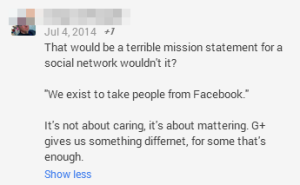 Step three: Start following some of the people whom Google recommends you to follow. Add them to your circles. But be sure you’re smart with your circles. Start slowly. Look, listen, then start +1ing the content you like. Realize that, on Google+, you can actually engage with everyone and anyone you meet. It’s not ageist, it’s not sexist, it cares nothing about caste, celebrity, success, or education (well, that’s not entirely true. Google Plus is a meritocracy, as are all online communities. Forget about “don’t be evil,” — don’t be stupid!)
Step three: Start following some of the people whom Google recommends you to follow. Add them to your circles. But be sure you’re smart with your circles. Start slowly. Look, listen, then start +1ing the content you like. Realize that, on Google+, you can actually engage with everyone and anyone you meet. It’s not ageist, it’s not sexist, it cares nothing about caste, celebrity, success, or education (well, that’s not entirely true. Google Plus is a meritocracy, as are all online communities. Forget about “don’t be evil,” — don’t be stupid!)
Step four: Keep on adding people to your circles who you find interesting or compelling. Spend more time engaging in comments and +1ing for a couple of weeks until you get a feel for the community and people start getting to know you. I call it the “goldfish in the bag” time — where you’re in the fish tank but you’re still in the water in the clear plastic bag you were sold in in order to acclimate to the water temperature and your surroundings before you really commit to moving in.
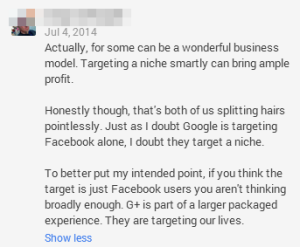 Step five: Start posting your own content. Be sure that you share other people’s content as well. It’s not about dropping links from your own articles. It’s sort of like Reddit or Wikipedia in that respect. If your content isn’t good enough for other people to share onto Google+, it probably isn’t good enough (that really stung to realize, personally).
Step five: Start posting your own content. Be sure that you share other people’s content as well. It’s not about dropping links from your own articles. It’s sort of like Reddit or Wikipedia in that respect. If your content isn’t good enough for other people to share onto Google+, it probably isn’t good enough (that really stung to realize, personally).
Step Ssx: Rinse and repeat, every day.
Good news & bad news
Despite Google’s overtures, I missed the fact that none of my friends were there — or, they were there but not participating. Brands generally weren’t there, friends weren’t there, and even people who are, aren’t there very long.
While people generally like what they see on first blush, they eventually leave the empty austerity of Plus to return to the messy excitement of Facebook, Pinterest, Tumblr, Twitter, and Reddit. And, at the end of the day, I just kept engaged with Plus because I was afraid not to: I do Search Engine Optimization, Online Reputation Management, and endlessly promote my own writing and content, so I just assumed that posting onto G+ regularly would in some way curry favor with the Google Gods.
The good news: Google+ is probably one of the smartest, interesting, intelligent, interested, and compelling virtual online communities ever created. G+ is a worthy inheritor of Real Name communities like The WELL, The Meta Network, EchoNYC, and even USENET. The conversation — both the initial posts as well as the commentary — is longer-form and can thread down into infinity. The people are loyal, devoted — often zealous — and are as likely to be photographers, educators, writers, physicists, philosophers, and artists as they are celebrities or featured guests. The people who live on Google+ are in love and cannot even consider spending their time, energy, and limited free time anywhere else.
 The bad news: what I said in my last post is still true: If you’re just casually interested in making a virtual online community home on Google Plus, you’re still screwed. I was told, again and again, that if I had spent three years in the desolate wilderness of Google+, desperately holding on and sending out my weak olly olly oxen free in the form of posting, sharing, and dropping articles I had written, then I was doing it wrong. That I hadn’t wanted it enough. That I was to blame. That if I had really wanted to be a joiner, I would have. That my shitty experience on Plus is all me and had nothing at all to do with the social network — sorry, social layer — at all.
The bad news: what I said in my last post is still true: If you’re just casually interested in making a virtual online community home on Google Plus, you’re still screwed. I was told, again and again, that if I had spent three years in the desolate wilderness of Google+, desperately holding on and sending out my weak olly olly oxen free in the form of posting, sharing, and dropping articles I had written, then I was doing it wrong. That I hadn’t wanted it enough. That I was to blame. That if I had really wanted to be a joiner, I would have. That my shitty experience on Plus is all me and had nothing at all to do with the social network — sorry, social layer — at all.
On Google+ I feel a little like Frankenstein’s monster
I’m in trouble. There’s a posse out to lynch me because of what I’ve been reporting about Google+: it’s a ghost town! It’s a spam box! The only reason to be there is to curry favor with Google for organic SEO benefit. I feel terrible, too, because there’s apparently very passionate members of this community, too. Folks who are not merely passionate about Google+ but simply devoted. Committed. To the exclusion of all others.
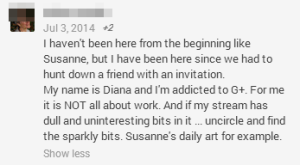 All I know is that I have been a member of Google+ from the very beginning — for very close to the entire three years it’s been nothing but a ghost town for me. Simply an elaborate connective tissue stitching together all of Google’s more compelling properties like Search, Picasa, Hangouts, and YouTube.
All I know is that I have been a member of Google+ from the very beginning — for very close to the entire three years it’s been nothing but a ghost town for me. Simply an elaborate connective tissue stitching together all of Google’s more compelling properties like Search, Picasa, Hangouts, and YouTube.
Well, my initial experience with the Google+ mob is that they’re committed to blaming the victim: me and all the folks who are unwilling to negotiate the initial desolation of the initial G+ experience we’ve all experienced as default Google+ members. We’re all Google+ members, right, just because we’ve all got Gmail accounts. Just by the virtue of that common thread, the designers of Google Plus should have “dumbed down” Plus in order to encourage everyone and anyone who has a Google webmail account to also have at least a brilliant kiddie pool experience with G+ as well — even if requires water-wings and a watchful parent nearby.
My friend BL Ochman loves Google+ and believes me wrong about everything. I agree that Google+ is pretty great, theoretically, sure — and the tools are gorgeous and shiny — but even BL sees little worth, especially in her most recent article, Dear Google: You are doing a terrible job of explaining Google+. It sounds like she’s worried.
Do you use Google Plus? If so, why?
So let me ask you: do you use Google+? Do you or your company have Google+ Business Pages. Do you have a community on Google+? And, if so, how often do you visit? How much time have you committed? How long did it take you to become a bona fine Plusser?
I found the Google+ affirmation graphic on Google Plus (at top), and it really makes me want to find a home there.
When I read through this list I feel pretty bad about spending the last three years dropping links and Facebook content into Plus as an afterthought. Sort of writing compulsory checks to my church instead of believing in God. Just because, that’s what you gotta do. Maybe I have been mistaken. Probably.
This proves that everyone on Google Plus think they’ve invented the virtual online community. Not Lisa Kimball or Scott Burns and TMN.com or Howard Rheingold and The WELL. It’s sweet, actually. Just like when millennials act like they’ve discovered the orgasm or something sweet like that.
I’ll stop giving Plussers any more grief. It’s just evangelical zeal. The passion and obsession of the newlyconverted. It’s actually lovely. Hopeful. It just means that persistent and intimate community online is not a vestige of the past but something that’ll persist into the future.
On the other hand, one of the nicest things about my online message boards and forums about motorcycles that I frequent is that there are posted FAQs, pinned suggestions, rules of the (forum) road, and also a bunch of old timers, moderators, admins, high-post-counters, and other fanatics who have taken it upon themselves to take me under their wings, facilitate my experience, and encourage me to come back and have a fulfilling time.
My organic experience with Google+ has been more sink or swim. More pass or fail. And, that’s the missing piece.
(H/T to Attorney Jason Kalafat for his support in developing this page)
The post Why Google Plus is more like a forum than a social network appeared first on Inside Social Media.
]]>The post Enlist the power of the crowd for your next live event appeared first on Inside Social Media.
]]>
How to leverage your audience’s Instagrams, tweets, Facebook posts, blogs, Tumbls & G+s
Target audience: Marketing professionals, PR pros, brand managers, businesses, SEO specialists, nonprofits, educators, Web publishers, journalists.
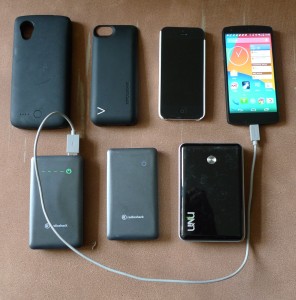
 Ican’t believe you’re still hiring professional photographers with expensive DSLRs who shoot your events live but time-delay the results by days and weeks. Yes, I am looking at you!
Ican’t believe you’re still hiring professional photographers with expensive DSLRs who shoot your events live but time-delay the results by days and weeks. Yes, I am looking at you!
I am not saying you shouldn’t hire a professional team for posterity, the annual reports, and your organization’s archive. But why are you time-delaying your fundraisers, events, conferences, gatherings, jamborees, and rally by hours, days, and weeks when you have all the cheap-and-accessible tools all around you to take dozens of “good enough” images real-time, allowing hundreds, thousands, and millions of friends, family, fans, and potential donors, clients, customers, attendees, and members to get a selective and well-curated peek into all the cool stuff you do every day, as it happens, live, en masse, over the course of the entire event, instead of only the tightly-edited album you may only share with your current friends and family, all in one dump, at one moment, well after the event is far in the rear view mirror?
Yes, those professionally shot 16.2 megapixel photos may well be well-lit, hi-def, perfectly posed, and color-corrected, but they’re also planned, dull, and edited down to so few images that all you’re left with are some boring photos of some random “celebrity” at a dais, some sponsors, board members, and honored guests mugging in a huddle, some glad-handing photos, and maybe a snappy of plates of rubbery chicken on linen-festooned banquet tables.
Expand your reach beyond who’s in the room
Keep the pro shooters but look to others who might be willing to live tweet, Vine, Instagram, Google+, Facebook, Pinterest, and Tumbl on your behalf, logging in to your Twitter, Vine, Instagram, Google+, Facebook, Pinterest, and Tumblr accounts before the night begins.
Alternately you can follow my advice below and get the sort of impact you need from the events that you’ve spent a lot of money and energy on already — events that could really help your brand profile in the noisy, noisy, world — but at which there are only dozens to hundreds of attendees and not the thousands-upon-thousands you’ve acquired through social media marketing across all of your social networks and social sharing platforms. Plus, there’s the excitement of the check-in, be it checking in on Foursquare, Facebook, Google Plus (or even on Foursquare through Instagram, actually).
Live streaming, live-tweeting, Instagramming and Vine
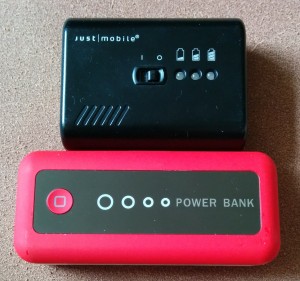 When I know I need to capture an event via social media, I use two smart phones and several huge, portable, backup batteries. Strangely enough, too few people carry backup batteries for their smart phones.
When I know I need to capture an event via social media, I use two smart phones and several huge, portable, backup batteries. Strangely enough, too few people carry backup batteries for their smart phones.
My two smart phones are an Apple iPhone 5 and a Google Nexus 5. The 5 has passable battery life, the Nexus 5 dies within an hour the way I use it. As a result, I fill up two Radioshack Portable Power Banks, each with 6000mAhs, every night.
The best thing about porting around too many batteries and cables? Well, you can hook your staff and the folks who are attending up with batteries and charging cables and still have your battery needs covered as well. In fact, you might decide to buy a bunch of batteries and chargers and adapters and plugs and maybe even have a safe charging station where people can leave their poor depleted phones. If you play your cards right, half of the people in your banquet hall will be attending your event through the lens of the video display of their smart phone. No, not their camcorder, DSLR, or Canon snappy, but their smart phone, uploading their Vines, Instagrams, tweets, and Facebooks, blogs, Tumbls, and Plusses right then and there, an entire corps of paparazzi.
Make wi-fi an ally, and buy some wi-fi repeaters
Also, offer some really good Wi-Fi, try to not require a password, or make the password so easy and free that it’ll not be a trouble. I recommend buying a number of Wi-Fi repeaters, such as the NETGEAR WN3500RP Universal Dual Band WiFi Range Extender or the cheaper NETGEAR N300 WiFi Range Extender Wall Plug Version WN3000RP — they’ll allow you to fill your halls with sweet wi-fi, amplified from the distant, weak, signal that you’re all using at once. It won’t solve anything, but it’ll boost confidence and the number of bars people see on their phones. And, if I am really busy, I’ll just live in Instagram. I can take short videos on Instagram, a-la-Vine, and also some pretty neat filtered-and-edited images, be it #filter or #nofilter.
Train everyone how to promote your brand via social
 If you’re Miriam’s Kitchen, you should bring me in! If you’re not, maybe you can pay me to come in to train up your staff on who, what, when, where, why, and how to properly and professionally document brand, organization, corporate, or foundation events, including location-awareness, checking-in, swarming. Make sure people understand constraint, what you’d like, filters, cropping, titling, descriptions, tagging, hashtagging, @-inclusions, profile-tagging, checking-in, and all the yummy stuff that make these things cool.
If you’re Miriam’s Kitchen, you should bring me in! If you’re not, maybe you can pay me to come in to train up your staff on who, what, when, where, why, and how to properly and professionally document brand, organization, corporate, or foundation events, including location-awareness, checking-in, swarming. Make sure people understand constraint, what you’d like, filters, cropping, titling, descriptions, tagging, hashtagging, @-inclusions, profile-tagging, checking-in, and all the yummy stuff that make these things cool.
Spend some time sharing how Twitter is different than Vine is different than Facebook is different than Instagram is way different than Google+, a platform that makes it hard to ever even cross-post to it. You need to explain the difference between posting to Facebook and Google+ profiles versus Google+ and Facebook Page posting (it’s important). And then, be sure that people realize that every single person you photograph wants to look beautiful, skinny, happy, successful, fit, and kind, so don’t post any photos that show people with double-chins, belly rolls, closed eyes, or food and drinks up in their pie holes. Make sure every image you make and every post you commit to is flattering and lovely. Not because you’re trying to misrepresent the event but because if you post anything awkward, embarrassing, or unflattering, you’ll surely hear about it. Consider twice, post once.
Let your entire team post as your organization
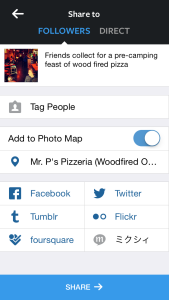 This takes both training and trust, guys, but you’ll be well-rewarded for your trouble. Get together before the event and either pile all the smart phones on a table and let a couple geeks who know their way around Instagram, Vine, Twitter, etc, set everyone up on their own phone with direct access to the brand’s account. Alternately, maybe you can get a bunch of phones that are the property of the organization and hand them out for the night, already set up for the Wi-Fi and pre-logged in for all the sharing platforms you intend to you. Hopefully you’ve already trained everyone up and let them all know how to best fill out all the content you need before posting, including using filters and light photo editing skills.
This takes both training and trust, guys, but you’ll be well-rewarded for your trouble. Get together before the event and either pile all the smart phones on a table and let a couple geeks who know their way around Instagram, Vine, Twitter, etc, set everyone up on their own phone with direct access to the brand’s account. Alternately, maybe you can get a bunch of phones that are the property of the organization and hand them out for the night, already set up for the Wi-Fi and pre-logged in for all the sharing platforms you intend to you. Hopefully you’ve already trained everyone up and let them all know how to best fill out all the content you need before posting, including using filters and light photo editing skills.
You also need to inform people what to do if there’s a terrible auto-correct mistake, a miss-post, or a misspelling: delete it yourself? What if it’s been cross-posted via Instagram to Flickr, Facebook, Twitter, Foursquare, and the lot? Is there someone at a desktop who can be a live air-traffic-controller? Is there someone you can text or call? Is there someone who can monitor all the streams to quickly delete any and all posts that don’t make the mark (without hurting anyone’s feelings?)
Empower your attendees to live-tweet about you
 I love to live tweet events for Vocus and Miriam’s Kitchen — for free. I love how lovely they are to me.
I love to live tweet events for Vocus and Miriam’s Kitchen — for free. I love how lovely they are to me.
They invite me to things and spoil me and make me happy and amused — and when it comes to Miriam’s Kitchen, I am changing lives! I know there are loads of people who work with Miriam’s Kitchen who would love to be tapped as a either part of above-mentioned “Team Tweet” or as part of the friends and family Team Livetweet that the attendees are more than welcome to become. In the case of Miriam’s Kitchen “Mission Possible” fundraising gala, they’ll want to devise a hashtag that everyone can use for the event, maybe #missionpossible or #missposs14 or #missposs — who knows — as well as the proper mention in every post, including @miriamskitchen. Maybe the hashtag could even be #mp14 to make sure the hashtag is as easy and simple and short and east-to-include as possible — and is in every single social media post.
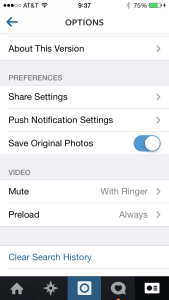 And, be really generous with the retweets, reblogs, reposts, starring, favoriting, hearting, and all that. I know I already said it but it demands repeating.This requires some training, of course, and something you’ve already offered to your team, but it also requires doting and appreciation, too. I always live tweet, Vine, Facebook, Tumbling and Instagram all of my volunteering at Miriam’s Kitchen. Every single time. Because I love them. However, I work twice as hard doing it whenever I get lots of love, appreciation, favoriting, liking, hearting, retweeting, and reposting. So, one of the mandatory jobs that the air-traffic-controller needs to do is engage all of the live-tweeting attendees! You need to. Maybe, you even need to set up a moderated and curated screen that features the social media conversation that’s happening, real-time. Hey, it works for professional sports teams with their fans, it works like catnip if you really want people to live tweet your event.
And, be really generous with the retweets, reblogs, reposts, starring, favoriting, hearting, and all that. I know I already said it but it demands repeating.This requires some training, of course, and something you’ve already offered to your team, but it also requires doting and appreciation, too. I always live tweet, Vine, Facebook, Tumbling and Instagram all of my volunteering at Miriam’s Kitchen. Every single time. Because I love them. However, I work twice as hard doing it whenever I get lots of love, appreciation, favoriting, liking, hearting, retweeting, and reposting. So, one of the mandatory jobs that the air-traffic-controller needs to do is engage all of the live-tweeting attendees! You need to. Maybe, you even need to set up a moderated and curated screen that features the social media conversation that’s happening, real-time. Hey, it works for professional sports teams with their fans, it works like catnip if you really want people to live tweet your event.
Keep it simple, keep it Instagram
Like I mentioned earlier, Instagram is easy. It’s all photo-based, it doesn’t really need too much writing when you’re in the lurch, and it does an amazing job of cross-posting across Facebook, Flickr, Tumblr, Twitter, and Foursquare. Only thing is, you’ll need to make sure you connect your Facebook to the correct place: Pages and not personal timelines.
Post to brand pages and not personal timelines
Instead of your own personal Timeline, if you’re a Team Livetweeter, you should like to the Facebook Page you need to be associated with. There are two ways: Either log in as someone who already has permission to post to your brand’s Facebook Page; or, the FB Page administrator needs to make you an administrator of their Facebook Page. Alternately, if you’re the admin, you’re responsible to add everyone who needs to post to your brand’s Facebook Page access to that page, by adding them all as managers for the course of the event. Then, if it’s no longer useful or necessary, remember to remove their access as managers after the event is over.
You can always pare down the flood of posts later
 There will be too many posts over the course of your event, especially if you give every team member who wants it, access to tweeting, etc, on your behalf as you, real time, but that’s OK. The next day (or that night) you can edit, edit, edit. It’s OK. Or just leave it. If you’ve done a good job promoting your event or your conference well in advance to your followers, members, and fans — and if you let them know you’ll be live-tweeting (and which hash tags you’ll be using) — then they’ll forgive the flood. Let it be, let it go — enjoy the rush. But, it is worthwhile going through everything with a fine-tooth comb, looking for unflattering images or adding tags to untagged photos if you recognize people and are connected to them via social media.
There will be too many posts over the course of your event, especially if you give every team member who wants it, access to tweeting, etc, on your behalf as you, real time, but that’s OK. The next day (or that night) you can edit, edit, edit. It’s OK. Or just leave it. If you’ve done a good job promoting your event or your conference well in advance to your followers, members, and fans — and if you let them know you’ll be live-tweeting (and which hash tags you’ll be using) — then they’ll forgive the flood. Let it be, let it go — enjoy the rush. But, it is worthwhile going through everything with a fine-tooth comb, looking for unflattering images or adding tags to untagged photos if you recognize people and are connected to them via social media.
This is a great opportunity to follow people who love you already. It’s also an opportunity to thank people personally for their help. I might even collect all the people who live tweeted (and retweeted and favorited and so forth, even if they were not in attendance) and then include them in a #followfriday love pile. If someone’s willing to tweet you, they’re worthy of your like; if someone’s willing to live-tweet you (for free) then they’re worth of your love.
Post best-of photos in an album afterward
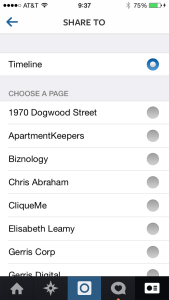 When you get your images from those fancy Canon, Sony, and Nikon DSLRs, upload them and post those guys to social media, of course, but also create “Best Of” albums as well, highlighting the best life-tweeted, live-Tumbl’d, live-Facebooked, and live Flickr’d photos and posts into one big pile of appreciation and love, including not only the life-tweeting teammates but also the best-of photos and tweets from the attendees as well — and include attribution and links and so forth. They’ll love being part of that end-of-party page-3 mention, especially of they’re tagged and thanked. How do I know? Well, because I really appreciate it. It’s some hard work, I warn you, but they work will only take you a couple-few hours on the Monday afterwards (or even the Sunday after, if you’re a workaholic) but you’ll really make people’s day! And, they’ll brag, share comment, and make a fuss again and again, well after the event’s been long forgotten.
When you get your images from those fancy Canon, Sony, and Nikon DSLRs, upload them and post those guys to social media, of course, but also create “Best Of” albums as well, highlighting the best life-tweeted, live-Tumbl’d, live-Facebooked, and live Flickr’d photos and posts into one big pile of appreciation and love, including not only the life-tweeting teammates but also the best-of photos and tweets from the attendees as well — and include attribution and links and so forth. They’ll love being part of that end-of-party page-3 mention, especially of they’re tagged and thanked. How do I know? Well, because I really appreciate it. It’s some hard work, I warn you, but they work will only take you a couple-few hours on the Monday afterwards (or even the Sunday after, if you’re a workaholic) but you’ll really make people’s day! And, they’ll brag, share comment, and make a fuss again and again, well after the event’s been long forgotten.
Remind your team to log off from your brand’s social media accounts
Don’t forget to get all of your trained up team mates and staff to unlink their social media accounts to your profile. Maybe even check, There are so many stories of people forgetting to log off from their corporate profiles only to tweet and post totally inappropriate photos that night after a few too many Fireball Cinnamon Whisky shots at the after, after party. I know you can do it. It’s so worth it.
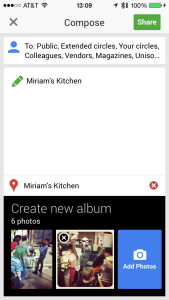 I think I have made it more complicated and complex than it is because I really would love people to do live-tweeting in a super-big way.
I think I have made it more complicated and complex than it is because I really would love people to do live-tweeting in a super-big way.
I want a hundred people to be making a noise on behalf of fundraising events, symposia, or conferences. Every conference should be its very own SXSX! You can always scale everything down to just a few people. Also, ask your lawyers. Maybe you’ll need to post a note at the entrance letting people know that the event will be live-tweeted to social media and that their likeness will probably end up somewhere on the Interwebs, “just in case you’ve invited your secret lover to this event and don’t want the entire world — and your spouse — to know.”
Go git ‘em! I know you be able to rock it, move the chain, and get yourself your very first Twitter trending topic!
Main photo credit: Jason A. Howie via photopin cc
The post Enlist the power of the crowd for your next live event appeared first on Inside Social Media.
]]>The post How to engage bloggers down the long tail appeared first on Inside Social Media.
]]>
Target audience: Marketing professionals, PR pros, brand managers, SEO specialists, businesses.
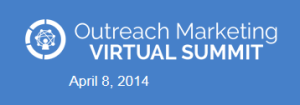
 It’s essential for brands to have access to and a relationship with their current customers and clients as well with their fans, natural allies, their topical neighborhood, and their prospective and future clients. In a post-Internet world, this is best handled online, for efficiency’s sake.
It’s essential for brands to have access to and a relationship with their current customers and clients as well with their fans, natural allies, their topical neighborhood, and their prospective and future clients. In a post-Internet world, this is best handled online, for efficiency’s sake.
No matter how obscure your product, service, book, business, or project, there are surely thousands and thousands of online denizens who may not yet know of you but who would be as pleased as punch if you were to reach out. Outreach marketing, formerly known as blogger outreach, is a powerful tool with almost zero barrier to entry — just your time and attention.
If you’re seeing this post on Monday, April 7, or in the morning of Tuesday, April 8, you’ve got a treat if you can make the time. GroupHigh is presenting a day-long event called the Outreach Marketing Virtual Summit the entire day of April 8th, 2014, between 10AM and 7PM Eastern Standard Time. It’s free and online so register!

Be sure to clear your calendar and spend the day with Bill Brennan, Bryan Kramer, Crosby Noricks, Bridget Duffey, Sam Zivot, Robin Carey, Phil Butler, Stephanie Scott, Andy Sernovitz, Lee Odden, John Hendricks, Danica Kombol, Katie Paine, David Meerman Scott, Lynette Young, Tracey Parsons, Laura Fitton, Travis Wright, Mary Eitel, Zoe Waldrom, Andy Theimer, Maddie Grant, Katie Greenlaw, Shelley Kramer, Heather Whaling, Kristen Matthews, and me. I’ll be presenting between 2:20 and 2:40 PM EST, 11:20-11:40 PST, and 19:20 BST for you gang in the UK.
But since the presentations are pre-recorded, each of us presenters can spend our twenty-minute presentation times responding live to tweets, chats, and questions. I think it’s a brilliant idea because whenever I am participating live in a webinar or QA session, I don’t have the personal bandwidth to answer questions and queries as they come in. Just for the record, tomorrow’s hash tag is #outreachmarketing and my personal Twitter handle is @chrisabraham — I hope to see you there.
I have done blogger outreach campaigns for the Alzheimer’s Association, Greenpeace, Habitat for Humanity, HSN, Kimberly-Clark, Sage 50, Mitsubishi Motors, Sharp, Snapple, Snuggle, Levi’s, CliquMe, Stever Robbins, City Creek Center, Miznuno Runnning, and others.
Every one of these companies, organizations, and non-profits could easily find an enormous pool of friends, followers, allies, and brand ambassadors with whom to engage and for whom news about each brand introduced through a pitch resulted in powerful earned media mentions, buzz, conversational volume, tweets, retweets, Likes, and posts on Pinterest, Tumblr, blogs, Facebook, and Google+.
It’s not rocket science but it requires that you get over yourself and start treating all of those Likes, followers, subscribers, and Pinners with a heck of a lot more respect than you probably do right now.
Remember, each and every one of the billions of real social media profiles around the world represents one or more human souls. Real people with real hopes, dreams, passions, wants, and needs. Discovering and engaging with the magic hundreds, thousands, tens-of-thousands who are already passionate about you is a start — and a great first step — but then going further to find those magic tens of thousands who don’t know you yet? Now that’s when the magic starts happening.
And, because there’s effectively zero barrier to entry, I would love to tell you everything I know about how I do it in a brief 20-minute Slideshare and PowerPoint presentation. In preparation of my session, How to Engage Bloggers Down the Long Tail, I have both uploaded the presentation deck up to Slideshare and the pre-recorded presentation to YouTube — so, you’ll be prepared to ask me any and all questions you may have about the presentation, my process, and even questions you may have about things that are going on with you in your business.
The post How to engage bloggers down the long tail appeared first on Inside Social Media.
]]>The post Using brand ambassadors to complement your social media campaign appeared first on Inside Social Media.
]]>
Brand ambassadors know the difference between establishing contacts and spamming.
Target audience: Marketing professionals, SEO specialists, PR pros, brand managers, businesses, nonprofits, educators, Web publishers, journalists.
Post by Andrew Lisa
 In the beginning of the brand ambassador movement, the job entailed – and still does, to a certain degree – “going out” and announcing the brand to interested parties. Social butterflies who enjoyed interacting with people, early brand ambassadors combed nightlife spots, events, conferences, and parties, bringing with them the news about the business, whose intricacies they made it their business to obsess over.
In the beginning of the brand ambassador movement, the job entailed – and still does, to a certain degree – “going out” and announcing the brand to interested parties. Social butterflies who enjoyed interacting with people, early brand ambassadors combed nightlife spots, events, conferences, and parties, bringing with them the news about the business, whose intricacies they made it their business to obsess over.
Modern brand ambassadors are much more technologically inclined, and they spend much of their time “going out” on social media.
Built for social media
Modern brand ambassadors, by definition, are already adept at social media. Their job is to engage large groups of people and act as a liaison for the business they represent. The modern meeting place is no longer the nightclub but Twitter. Instead of a smile and a knack for conversation, their weapon is the hashtag.
Social media marketing
When it comes to social media marketing, there is a very fine line between a savvy player and an annoying spammer. A good brand ambassador knows the difference between true marketing and blanketing Facebook with ads and updates.
Gauging sales

Brand ambassadors are your business’s social media liaison to the world.
A good brand ambassador can estimate sales from the feedback they receive. With experience and instincts they can double as a social media marketing consultant and actually gauge potential profit with a fair degree of accuracy.
Your man (or woman) in the field
A good brand ambassador can build relationships with not just customers, but with business partners and even rival brands in the industry. Constantly building bridges, a top-notch brand ambassador is constantly using social media to network, not just to set up sales.
Credibility
As Americans become more wary of traditional advertising, brand ambassadors can fill the void by creating dialogue through social media. There is a credibly that comes with people talking about your brand instead of having it sold to them.
Humanization
Any social media marketing consultant will tell you that humanizing a business is the single best thing you can do to put a face on your brand. Jarred from Subway, for example, was one of the most successful brand ambassadors of the last 15 years. You can talk about health benefits and calorie counts until you’re blue in the face, but hearing the message from a living, breathing, regular guy who actually lost the weight is worth a thousand commercials.
Quality over quantity
A zillion Facebook likes and Twitter followers are great, but not if they’re coming from bots or dead accounts. A great brand ambassador knows the difference between quality and quantity, and can work to boil your social media contacts down to the important, relevant categories.
Brand ambassadors were built for social media, and vice versa. The social meeting place of the modern world, Twitter and Facebook are digital versions of the physical places to which the brand ambassadors of last generation flocked. The same rules apply, only the options for networking and creating dialogue are far more bountiful – and a good brand ambassador is always ready to harvest.
The post Using brand ambassadors to complement your social media campaign appeared first on Inside Social Media.
]]>